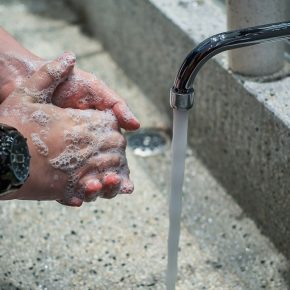
How to improve on-site health and safety measures
Health and safety are always at the forefront of the minds of responsible employers, but current times have perhaps made these issues even more prevalent, as this article explores…
In Europe, strict laws dictate how employers are responsible for ensuring a safe working environment and must continually be seeking to improve things.
With COVID-19 creating increased and new risks for all people in all shared places, including workplaces, additional measures are required.
Improving on-site health and safety, in relation to the virus, requires measures to enable social distancing – allowing staff to keep two metres apart where possible and one metre apart otherwise. Where that is not possible, such as in certain construction environments, additional steps are needed to mitigate risk.
As stated in the UK government’s ‘Working safely during coronavirus’ guidance, ways to improve on site health and safety in these times include:
Increasing the frequency of hand washing and surface cleaning
It is crucial that high levels of hand hygiene are maintained across teams. Providing antibacterial gels, dispensers and stations is one way to tackle this.
Not everyone can use those due to allergies or religious issues (given the gels contain alcohol). Additional portable hand wash stations are another potential solution.
Minimising the time spent on activities where social distancing is not possible
Businesses must consider activities that do not allow for social distancing; if they are key, the time spent on them should be kept to a minimum.
Employers need to ensure open dialogue with staff who may be at particular risk from the virus, and therefore at greater risk of carrying out non socially distanced activities.
Using screens or barriers to separate people from each other
Not only are solid perspex screens a potentially valuable source of protection against virus transmission during the current pandemic, they also act as a reminder and guideline for people.
Barriers can help to ensure people follow a one way system and avoid coming together in bottle neck areas, such as entrances and exits.
They also serve as a reminder to everyone to continue to maintain distancing. It is vital not to overlook break areas and canteens when enabling and signposting social distancing.
Reduce face-to-face working
Risks of COVID-19 transmission are reduced if face-to-face working and face-to-face communication is limited. Enabling and encouraging back-to-back or side-by-side working practices will work as a mitigating measure.
Create work team ‘bubbles’
Reducing the number of different people each individual comes into contact with will help reduce the risk of spreading should an incidence of the virus occur within the team.
This can be achieved by creating fixed teams and partnering systems to enable each person to only work directly with a few others.
Staggered breaks will help to enable this, when larger teams are all on site together. Staggering arrival and departure times or shifts are also considerations.
Other considerations
Improving health and safety on-site also requires thought around travel; whilst public transport firms, like Transport for London, are reiterating their own additional health and safety and hygiene measures, ensuring teams have choices about how to get to work to minimise risk will also help to improve safety for them and colleagues at work.
Measures such having ample parking spaces and bike racks will help provide options other than public transport for travel to work.
If van travel is necessary, thorough and regular cleaning of vehicles is vital, as is considering leaving seats empty to allow for social distancing.
Security keypads may need to be rethought to maintain security, but reduce the need for regular touching of the same surfaces.
Furthermore, supporting employees to wear face masks is also advisable.
Latest news

29th April 2025
Senior pledges to ‘bee’ part of the solution with new biodiversity initiative
Senior Architectural Systems has installed its first on-site beehive, marking another step forward in its commitment to sustainability and biodiversity.
Posted in Articles, Building Industry News, Building Products & Structures, Building Services, Curtain Walling, Doors, Glass, Glazing, Innovations & New Products, news, Restoration & Refurbishment, Retrofit & Renovation, Sustainability & Energy Efficiency, Walls, Windows
29th April 2025
West Fraser range delivering key benefits for South-East carpentry company
An experienced carpenter and building site manager who has recently set up his own company is using high performance panel products from the West Fraser range.
Posted in Articles, Building Industry News, Building Products & Structures, Building Systems, Case Studies, Garden, Restoration & Refurbishment, Retrofit & Renovation, Sustainability & Energy Efficiency, Timber Buildings and Timber Products
29th April 2025
CPD Courses Available Online From Ecological Building Systems
Ecological Building Systems, a leading supplier of natural building products for sustainable construction, has revealed its comprehensive CPD programme for the year ahead.
Posted in Articles, Building Industry Events, Building Industry News, Building Products & Structures, Building Services, Continuing Professional Development (CPD's), Information Technology, Innovations & New Products, Insulation, Restoration & Refurbishment, Retrofit & Renovation, Seminars, Sustainability & Energy Efficiency, Training, Walls, Waste Management & Recycling
29th April 2025
WindowBASE launches new prospect databases at FIT Show
Visit WindowBASE at the FIT Show to see first-hand how it helps companies find new customers – the company is launching an easy-to-use, intuitive platform on Stand G16 at the NEC Birmingham from 29th April – 1st May.
Posted in Articles, Building Industry Events, Building Industry News, Building Products & Structures, Building Services, Doors, Exhibitions and Conferences, Glass, Glazing, Information Technology, Innovations & New Products, Posts, Publications, Research & Materials Testing, Restoration & Refurbishment, Retrofit & Renovation, Windows
 Sign up:
Sign up: